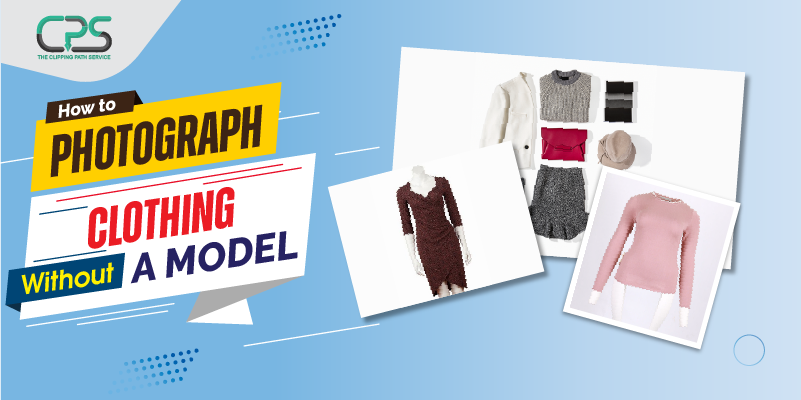
How To Photograph Clothing Without A Model
Managing a model for your clothing photo session takes a lot of hassle. Thus, learning how to photograph clothing without a model would let you go far ahead in the game. But it takes a little bit of practice to master the craft of clicking apparel photos. I understand your eagerness and made an easy-to-follow clothing photography process to go through.
Whether you are an e-commerce merchant or a store owner, learning to photograph clothes without a model would let you kickstart your business. Since you are shooting without a model, it takes less budget and time to complete and let alone the formality of photography contracts.
Clothing photography is easy to grasp even for beginners. If you put modest effort and time into learning the skill, it would be worth your every second. Let’s start covering each of the essential photography steps in detail.
Table of Contents
ToggleSteps on How To Photograph Clothing Without A Model
Trying to photograph clothing products without a model might seem difficult at first. But if you follow these proven steps you would be ready to create your clothing photography studio and click great photos.
Select Your Photography Style (Mannequin or Flat Lay)
First of all, you must select the photography style you are going to use. Although having a model is recommended, but you could use a mannequin for clothing photography as an alternative. Apart from the mannequin, you could go for flat lay photography as a cheap and fast process.
However, the mannequin is a model or statue resembling a human shape in its best way. Anyone can use the mannequin in a clothing photography studio to shoot fantastic photos. It makes the whole process a lot easier.
If you don’t have any mannequins, then a flat lay clothing photography setup would help you out. In the flat lay setup, you place your clothing on a flat surface. Afterward, place a camera right on top of the clothing and start taking photos
A quick pro-tip, you could stuff few tissue papers into the clothing to add some volume. It makes the clothing product look more realistic, says most experienced clothing photographers.
Setup Your Mannequin Or Flat Clothing Photography Kit
To start photographing the clothes, you need the proper equipment. These tools are the core of every successful clothing photography project. So let’s start break-down each of the equipment or items and talk more about it.
Mannequin
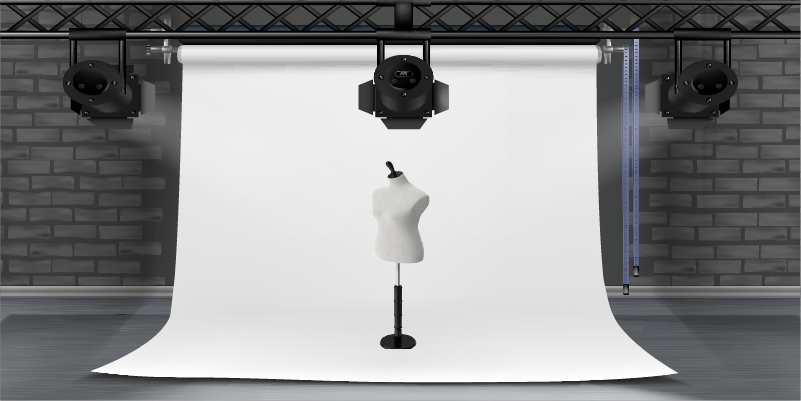
When you are going to use a mannequin for clothing photography, it’s the first and foremost item you need the most. However, if you are going to shoot clothes with flat lay photography, skip the mannequin and go for other equipment.
The mannequin comes in different sizes and shapes and you must choose the one which suits your clothing the best. Thus, you must consider having a mannequin with its hand attached. It’s not good for clothing photography if you use a mannequin that doesn’t have arms, because it would look awkward.
Camera Equipment
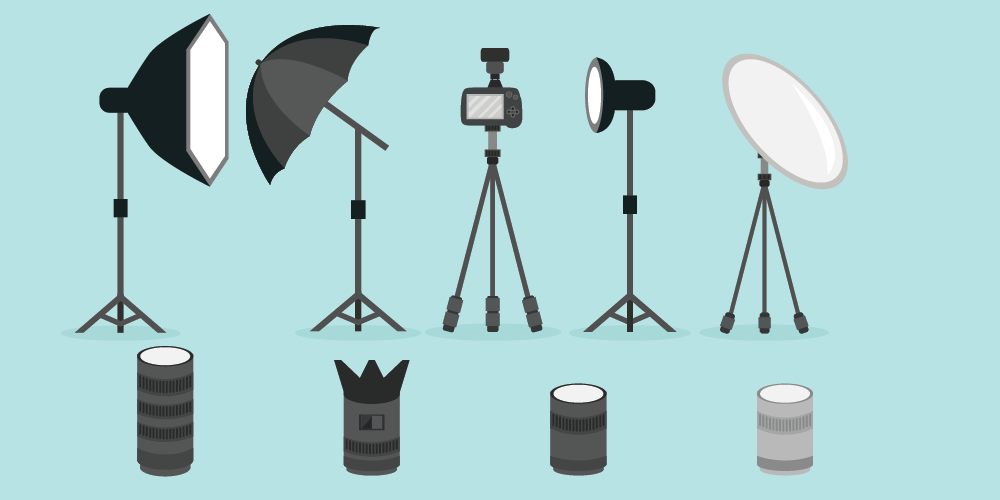
You could either choose a DSLR mirrorless camera or go with your smartphone cameras. In the smartphone category, many photographers tend to use iPhones. However, you could use any mobile phone which has ample camera resolution.
Mannequin Or Flat Lay Clothing Photography Lighting
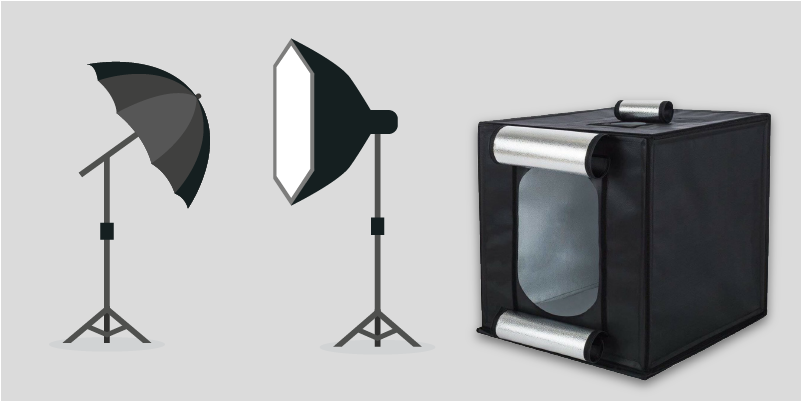
Whether you are doing a mannequin or flat lay photography setup, lighting comes crucial all the time. The first option is you could use natural light if your shooting spot is beside a large window. Flat lays photos would work great in natural lighting but for mannequin photography, you must set up an actual lighting kit.
However, even If you feel the natural lighting is not sufficient, creating a professional clothing photography studio with correct lighting would help you out. A lighting setup would bring up the contrast and vividness of your clothing photography.
Most of the time, three-point lighting is recommended. You could go for 2 bracket lighting and one top(hair lighting) as an optional.
On the other side, if you are doing flat lay photography, you could use the same lighting setup as well with two bracket lighting setups both at 45-degree angles. It would create sufficient brightness to go on.
It’s the same process even if you photoshoot with an iPhone. However, more on how to take pictures of clothes to sell with iPhone in the additional question section.
Tripod
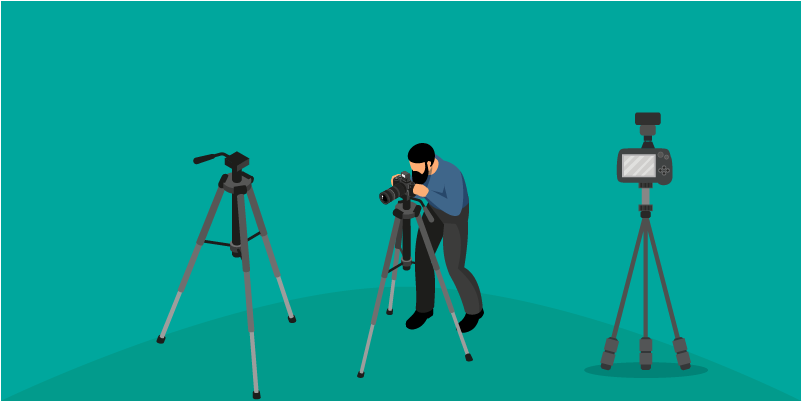
When you are using a mannequin for clothing photography, you would need to use a Tripod. It’s an efficient tool to stabilize the camera and provide consistency in your photos.
On the other hand, in flat clothing photography kits, there’s no option to use a tripod. You could take a photo with bare hands or use an additional adapter on a tripod to support and harness the camera or phone. Or you could use the Horizontal Camera Mount Adapter Kit which connects to the tripod.
Wireless Trigge

The wireless trigger makes your photography smooth. Because you don’t have to scratch your head off on making sure the camera doesn’t get any shakiness. Wireless triggers don’t cost as much as you think. It’s affordable and helps your photography a lot.
Configure Camera
DSLR Mirrorless Camera Users
If you are taking photos at a clothing photography studio, you must be using a mirrorless DSLR camera. If you are using a professional DSLR camera make sure you check out the below-mentioned configurations.
- Set the ISO of the camera at least to 100. It would make sure you get a decent quality. It’s better to have a lower ISO while doing any kind of clothing photography.
- In your camera settings set the aperture parameter higher as possible. It is also translated in-camera settings as f-count. you could set it around 10 to 14.
- You must set your white balance to the camera. The camera settings have options to alter the default white balance yet you should stay close to the automatic settings.
- Most clothing photographers put importance on shooting in RAW. It gives you the most flexibility when it comes to the post-production of photos.
Smartphone Camera Users
Want to master how to photograph clothing without a model with smartphones? make sure the smartphone has the correct settings as well. Don’t get it wrong, mobile phones can provide you with a professional look as well. Here are few crucial tips to keep in mind:
- Use tripods for mobile phones to keep consistency throughout the photoshoot.
- Clean up the phone lens and clean it before you start clicking photos.
- Keep your product always at the center of the mobile screen. Therefore, tap on the middle of the screen to get the clothing product at focus.
- Try to keep the mobile camera facing the clothing product at a straight angle. It lets you avoid any errors that may appear with different angles.
Learn How To Stage Clothes To Sell Online
Now comes the time to work on staging and the preparation. Before you start, you must check out if the clothing has any kind of wrinkles or stains on them. You must use an iron roller to remove these and make them perfect. Although you could remove clothing wrinkles via photoshop in post-production, still it’s best to make your clothing look fresh and complete.
As a quick reminder, if you have winter clothing, using a lint roller would make it tidy. Whether you are implementing clothing photography ideas at home or in-studio clean and organized photoshoots would win you business.
Keep those tips in mind as an extra step before clicking out the photo.
- Use clips on a mannequin if the fabric is way wider than the mannequin’s body.
- For flay lay photography, arrange a few pieces of tissue paper and gently push these into the cloth. Don’t overdo it as it may look bloated otherwise.
- As a rule of thumb, hide or cut out pricing tags, labels from your clothing.
- You could use a white or grayish backdrop or color suitable for the clothing. Yet, an off-white backdrop is the most recommended one.
Start Taking Clothing Photos
Once everything seems in place it’s time to press the button and capture your clothing product. Make your product in focus, framing is right and the camera is stable. Afterward, preview the whole image and then start taking photos.
Note: Don’t go for digital zoom as it may reduce the actual resolution of the image. Instead, use optical zoom or full view to get the highest resolution image out of your camera.
It’s a no-brainer to take multiple photos of your clothing products as most seasoned product photographers do it often. When using a mannequin for clothing photography, rotate it to different angles — especially 45-degree angles — and the backside of your clothing.
While taking photos, capture the details of your clothing as online customers tend to zoom into the image before buying it out.
Edit Your Photos
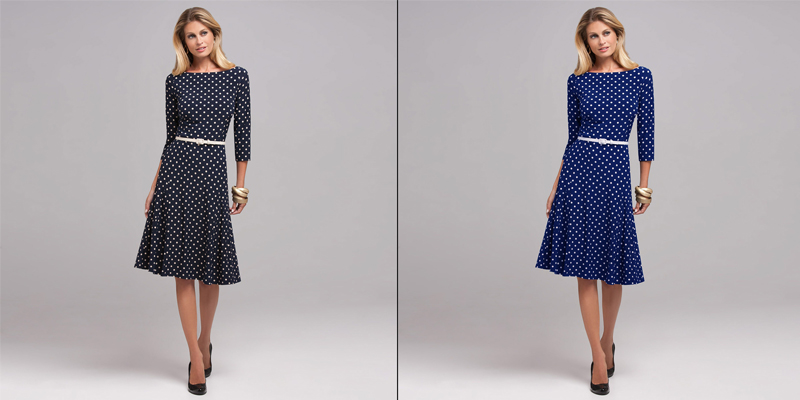
After clicking out all of your photos, it’s time for post-production where you purify your photo. It’s the final and most essential step in the process on how to photograph clothing without a model.
Editing and retouching photos is a tricky craft for photographers, perhaps outsourcing is the best option to go. Big e-commerce companies like Shopify, are favoring outsourcing clothing images with image retouching, and editing services.
In post-production, you could create ghost mannequin effects, fix out colors, wrinkles, and so on. It takes all visual errors out of your clothing photo and makes it look polished. You could choose any clothing photo retouching service provider to make your clothing photography projects seamless
Quick Guidelines On Clothing Photography
Below I am going upon guidelines on clothing photography which you must follow throughout the process. These guidelines or tips would let you get ahead of your competitor when it comes to the sheer quality of your photos. So, without ado let get right into these guidelines.
Always Use Mannequin If You Don’t Have Any Model
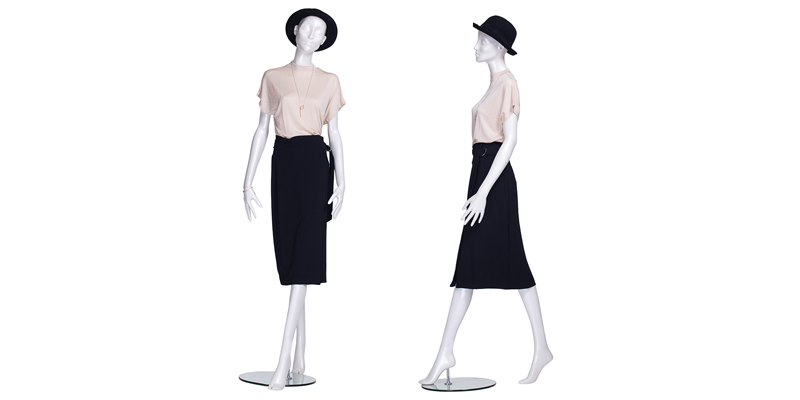
The ideal way to shoot is to use a mannequin for clothing photography. It lets you create the same volume and texture on the clothing as if someone is wearing it.
A mannequin would fasten up your photo shooting process a lot. Moreover, it works as a cheaper alternative to hiring a model for photography.
Note: In case a mannequin is not possible to arrange, use a flat clothing photography kit as the last option.
Use Ghost Mannequin Effect
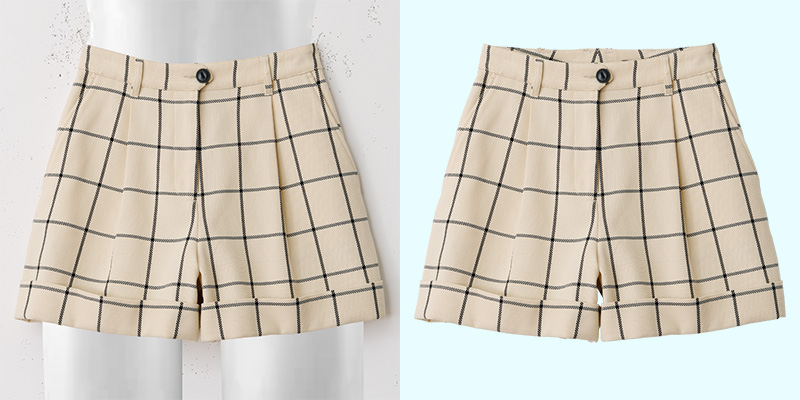
If you are photo shooting a clothing product on a mannequin, it’s recommended for you to use the ghost mannequin effect(neck joint). In the following effect, it creates an illusion as if a human shape is filling in the clothing. Yet the mannequin stays invisible in the photo creating a ghost effect.
The ghost mannequin effect is purely a photo editing technique using software like Photoshop. Though, all of it’s done in the post-production of your photoshoot. As it increases customer attention towards the clothing product, the ghost mannequin is popular among e-commerce stores.
Setup Lighting In The Right Way
Lighting setup could make or break your clothing photography. That’s why I set up the lighting with the correct composition. Using 2 bracket lights and 1 headlight is the optimum setup.
In Mannequin, you could place your 2 bracket lights at a 45-degree angle and the headlight right above the model. In other words, it’s called a 3-point lighting setup.
For flat lay photography, you could set up the light in the same way or use a complete flat lay photography kit to make the process faster.
Use A White Or Gray Background
A neutral background always wins in clothing photography. However, the initial background color is not so concerning as you could change the background using photo editing techniques.
Nonetheless, when you are using a backdrop sheet, try to use off-white or gray background. The plus point, these color backgrounds don’t distract you and don’t get mixed in with clothing colors.
As a quick starter, use smooth white paper as a background. It costs less and is easy to get your hands on.
Additional Questions
Below are the answers to frequently asked questions. Those would help you to get the overall knowledge on different aspects of apparel photography.
Q: How To Take Pictures Of Clothes For Instagram?
When taking pictures for photo-driven platforms like Instagram, go beyond the squire format. Use 1080 x 1920 pixels resolution. Analysis shows clothing pictures without squire shape perform better in the Instagram algorithm. Furthermore, shoot with daylight and have multiple photos of the same clothing. The flat lay clothing photography setup is proven to work better for Instagram
Q: How To Take Pictures Of Clothes To Sell With An iPhone?
First, configure the iPhone camera settings. I have mentioned before how you should configure your smartphone camera. However, the first piece of advice is to try to use daylight. Then take your clothing product in focus, Experiment with third-party camera apps. It’s better that you use a newer version of the iPhone to get a better resolution.
Conclusion
Learning how to photograph clothing without a model takes proper concentration. Steps like staging, lighting, and camera management become way more crucial. Don’t get the wrong impression though, mannequins and flat lay photographs are easy to grasp. With a few tries here and there it all comes into place.
Don’t take the burden to succeed with one try. Keep on shooting clothing photos and the quality would improve with each attempt. No matter which category you chose, mannequins or flat lay keep an artistry eye open.
Most of all, don’t forget to enjoy the whole process of shooting clothing photographs with all the equipment you have. Start doing it right now.

Bordie Capron
Author
“Bordie Capron is a Sr. Content Maker who is working in The Clipping Path Service an US-based image and video post-production company for over 7+ years. She completed her degree in graphic designing and worked as a graphic designing expert for several years. She always loved writing”
Categories
- Image Guidelines (12)
- Post Production (8)
- Pre Production (27)
- Review (16)
- Tips (51)
- Tutorial (18)
Recent Posts
Quick Response
Email:
cs@theclippingpathservice.com
Hotline Support:
Mobile: +1 (718) 717-2362

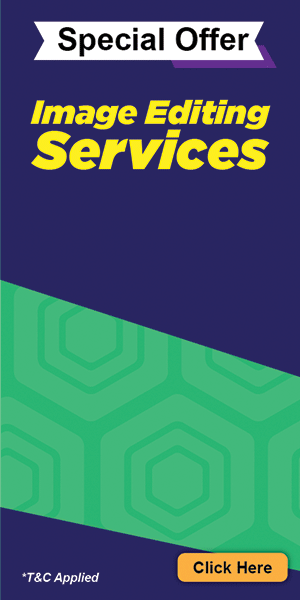
One Comment
John Barrett
Nice guide and tips that photographer can refer through. Thanks for it.